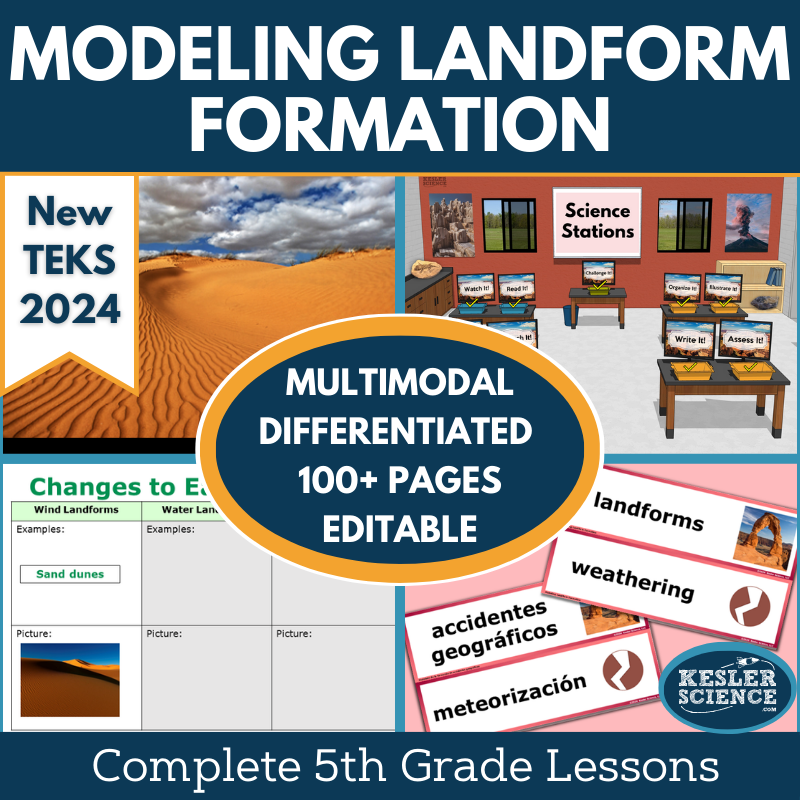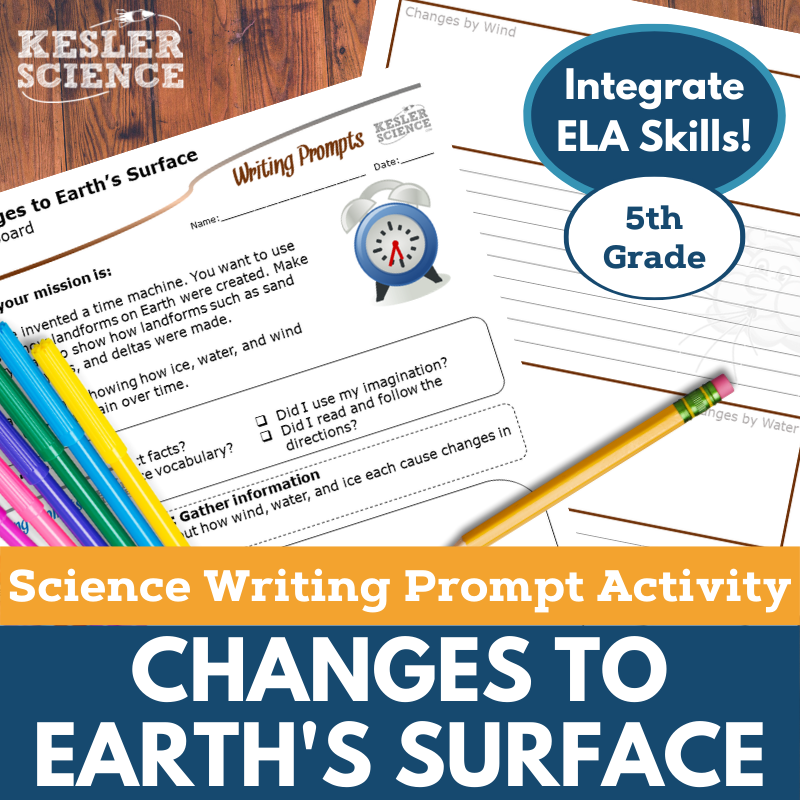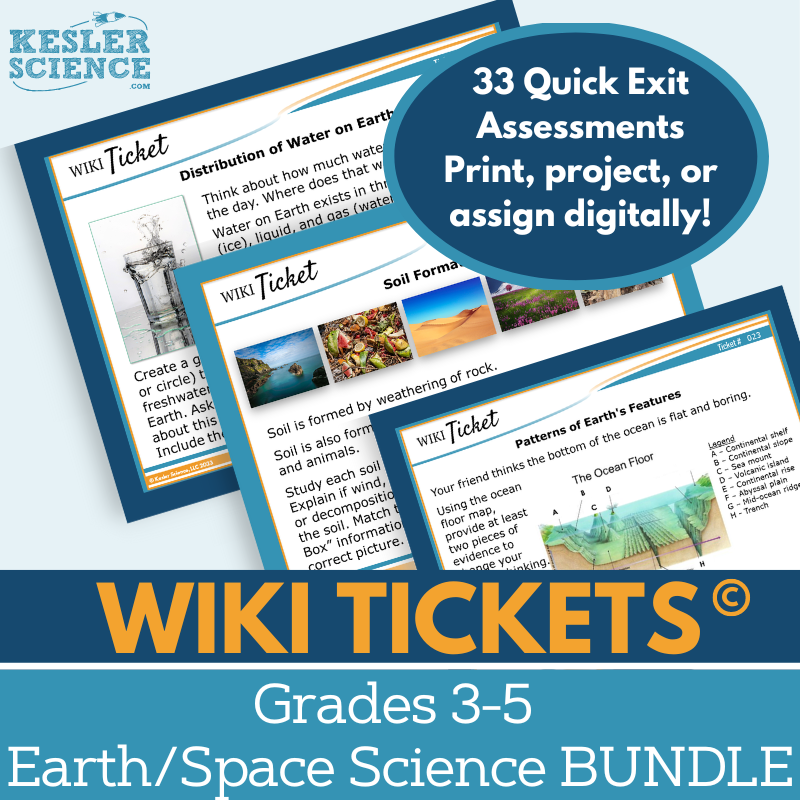Modeling Landform Formation Activities for 5th Grade Science
This 5th grade geology unit explores how wind, water, and ice shape Earth’s surface to create landforms like deltas, canyons, and sand dunes, aligned with TEKS 5.10C. The resources below will give students a comprehensive understanding of landform formations. All of the following materials are also included in the Kesler Science Membership.
This geology science unit for 5th grade focuses on how wind, water, and ice shape Earth’s surface to form landforms like deltas, canyons, and sand dunes. It includes editable PowerPoints, worksheets, choice projects, and assessments. The lesson follows the 5E model—Engagement, Exploration, Explanation, Elaboration, and Evaluation—and aligns with TEKS 5.10C.
In the Exploration phase, students engage in differentiated, student-led station labs. These include nine stations offering multimodal learning methods: “Explore It!” (hands-on demo), “Read It!” (differentiated reading), “Research It!” (web research), and “Watch It!” (video and discussion). Output stations include activities like card sorts, writing prompts, and illustrations. A bonus “Challenge It!” station offers extension activities for early finishers.
In the Explanation phase, students use editable PowerPoints and interactive notebooks in English and Spanish. Elaboration includes student-choice projects to extend learning, and Evaluation offers STAAR-aligned assessment questions and review worksheets. The content is flexible for both in-class and virtual learning environments.
This geology science unit for 5th grade focuses on how wind, water, and ice shape Earth’s surface to form landforms like deltas, canyons, and sand dunes. It includes editable PowerPoints, worksheets, choice projects, and assessments. The lesson follows the 5E model—Engagement, Exploration, Explanation, Elaboration, and Evaluation—and aligns with TEKS 5.10C.
In the Exploration phase, students engage in differentiated, student-led station labs. These include nine stations offering multimodal learning methods: “Explore It!” (hands-on demo), “Read It!” (differentiated reading), “Research It!” (web research), and “Watch It!” (video and discussion). Output stations include activities like card sorts, writing prompts, and illustrations. A bonus “Challenge It!” station offers extension activities for early finishers.
In the Explanation phase, students use editable PowerPoints and interactive notebooks in English and Spanish. Elaboration includes student-choice projects to extend learning, and Evaluation offers STAAR-aligned assessment questions and review worksheets. The content is flexible for both in-class and virtual learning environments.
This modular, student-led station lab aligns with the 2021 TEKS 5.10C standard on the changes to Earth’s landforms caused by wind, water, and ice. Designed for 5th-grade Earth science, the lab offers nine differentiated activities that engage students in modeling, identifying, and understanding the processes of erosion, weathering, and deposition. Students will explore these concepts through hands-on tasks, digital activities, reading passages, videos, and research, encouraging them to take ownership of their learning.
The station lab includes both input stations, such as "Explore It!" and "Watch It!", and output stations like "Illustrate It!" and "Write It!", providing multiple ways for students to demonstrate their understanding of landform formation. A bonus challenge station offers extension activities for advanced learners. With resources suitable for both in-class and virtual learning environments, this lab ensures that students remain engaged and develop a deeper understanding of Earth’s changing surface.
This modular, student-led station lab aligns with the 2021 TEKS 5.10C standard on the changes to Earth’s landforms caused by wind, water, and ice. Designed for 5th-grade Earth science, the lab offers nine differentiated activities that engage students in modeling, identifying, and understanding the processes of erosion, weathering, and deposition. Students will explore these concepts through hands-on tasks, digital activities, reading passages, videos, and research, encouraging them to take ownership of their learning.
The station lab includes both input stations, such as "Explore It!" and "Watch It!", and output stations like "Illustrate It!" and "Write It!", providing multiple ways for students to demonstrate their understanding of landform formation. A bonus challenge station offers extension activities for advanced learners. With resources suitable for both in-class and virtual learning environments, this lab ensures that students remain engaged and develop a deeper understanding of Earth’s changing surface.
The Modeling Landform Formations Student Choice Projects align with the 2021 TEKS Earth Science standard 5.10C, offering 5th graders a range of geology project options. A project page includes six student-led choices and an option to "design your own," with an editable rubric for teacher, peer, or self-assessment. Teachers can adjust the rubric as needed.
These flexible projects allow students to demonstrate their understanding in creative ways, with options that support both remediation and challenge. The resources are designed with standard classroom supplies in mind, and many projects can be completed digitally.
The Modeling Landform Formations Student Choice Projects align with the 2021 TEKS Earth Science standard 5.10C, offering 5th graders a range of geology project options. A project page includes six student-led choices and an option to "design your own," with an editable rubric for teacher, peer, or self-assessment. Teachers can adjust the rubric as needed.
These flexible projects allow students to demonstrate their understanding in creative ways, with options that support both remediation and challenge. The resources are designed with standard classroom supplies in mind, and many projects can be completed digitally.
The Changes to Earth’s Surface Science and ELA Integrated Writing Activity helps 5th grade students explore how wind, water, and ice shape landforms like deltas, canyons, and sand dunes. Aligned with TEKS, this engaging storyboard-based activity fosters science reasoning and writing skills, making it ideal for both in-person and virtual learning environments.
The resource includes teacher directions, a projection version for screen-sharing, full-sized and half-sheet handouts, and a digital interactive PowerPoint version that can be converted to Google Slides. It is versatile, suitable for cross-curricular work, pre-test assessments, student projects, differentiation, extra credit, and more. The activity can be used for elaboration, review, or as make-up work, and is designed for easy integration into interactive notebooks or writing journals.
This writing prompt supports student engagement and provides ample opportunity for creative exploration and science literacy.
The Changes to Earth’s Surface Science and ELA Integrated Writing Activity helps 5th grade students explore how wind, water, and ice shape landforms like deltas, canyons, and sand dunes. Aligned with TEKS, this engaging storyboard-based activity fosters science reasoning and writing skills, making it ideal for both in-person and virtual learning environments.
The resource includes teacher directions, a projection version for screen-sharing, full-sized and half-sheet handouts, and a digital interactive PowerPoint version that can be converted to Google Slides. It is versatile, suitable for cross-curricular work, pre-test assessments, student projects, differentiation, extra credit, and more. The activity can be used for elaboration, review, or as make-up work, and is designed for easy integration into interactive notebooks or writing journals.
This writing prompt supports student engagement and provides ample opportunity for creative exploration and science literacy.
WIKI Tickets formative assessments for 3rd-5th grade science provide a fun and engaging way to check student understanding. The Earth/Space Science Set includes 33 assessments, each with five formats: a full-screen projection version, three handout versions (full, split, and quarter-page sizes), and an interactive version for digital assignment through PowerPoint or Google Slides.
Aligned with NGSS and TEKS standards, these assessments cover key topics such as weather patterns, Earth’s surface changes, the water cycle, renewable and nonrenewable resources, and more. Some topics include multiple tickets, with a bonus table of contents file to show alignment.
These assessments can be used in both in-person and virtual learning environments, with options for projection, printouts, or digital use. They can serve as exit tickets, bellringers, or quick checks for understanding.
WIKI Tickets formative assessments for 3rd-5th grade science provide a fun and engaging way to check student understanding. The Earth/Space Science Set includes 33 assessments, each with five formats: a full-screen projection version, three handout versions (full, split, and quarter-page sizes), and an interactive version for digital assignment through PowerPoint or Google Slides.
Aligned with NGSS and TEKS standards, these assessments cover key topics such as weather patterns, Earth’s surface changes, the water cycle, renewable and nonrenewable resources, and more. Some topics include multiple tickets, with a bonus table of contents file to show alignment.
These assessments can be used in both in-person and virtual learning environments, with options for projection, printouts, or digital use. They can serve as exit tickets, bellringers, or quick checks for understanding.
Year-Round Resources
These year-round activities will increase your students' understanding of many middle school science topics. All of these activities are also included in the Kesler Science Membership.
Visual Data & Graphing
You're not alone if your students struggle with understanding graphs, charts, and tables. It's a skill that takes an enormous amount of practice. This resource will help students build a strong foundation in analyzing data and creating their own data visualizations.
Bell Ringers and Warm-Ups
These middle school science bell ringers are an excellent way to engage your students as soon as they walk into your classroom. This comprehensive FULL YEAR resource includes everything you need to start off each science class with an interesting warm-up activity.
Review Board Games
Each game board has been carefully designed to keep students engaged. There are 10 different action spaces on each board and dozens of question cards. All of the actions are related to science concepts and keep the students motivated throughout the game.
Each game is ready to play. Simply print out the board and the cards and let the students enjoy reviewing nine different units.
Essential Questions and Standards
Below are the essential questions and standards associated with the lessons and activities included in the atoms unit. This topic is only one of more than 100 middle school science topics included in the Kesler Science Membership.
-
Describe the processes that lead to the formation of sedimentary rocks and fossil fuels.
-
How can we model the processes that lead to the formation of sedimentary rocks and fossil fuels?
-
TEKS Science - 5.10C Modeling Landform Formations
Kesler Science Membership
Imagine never having to search for another middle school science lesson again. The membership gives you access to ALL of the Kesler Science products in one place (Yes, including everything above).
Say goodbye to long hours of lesson prep.











